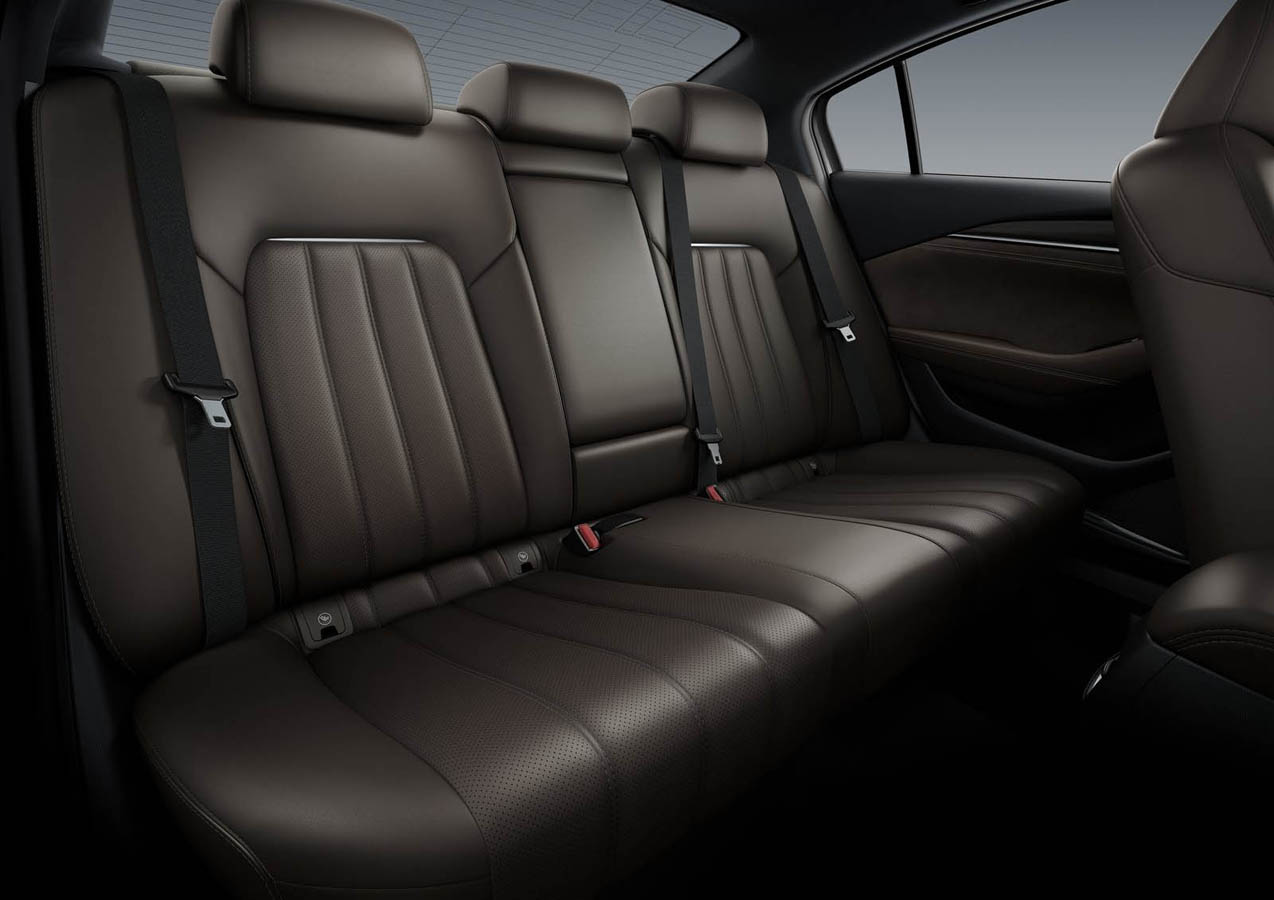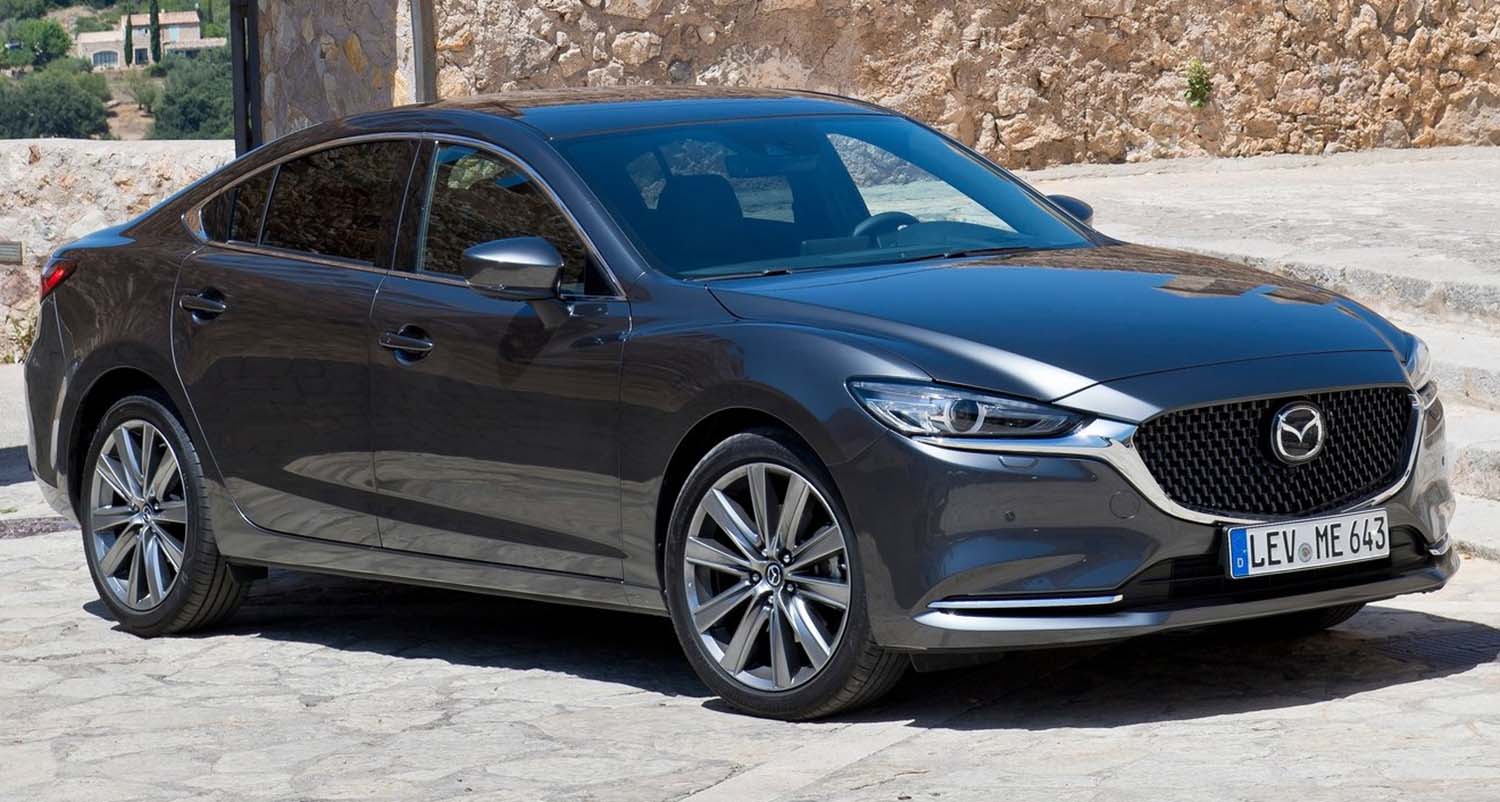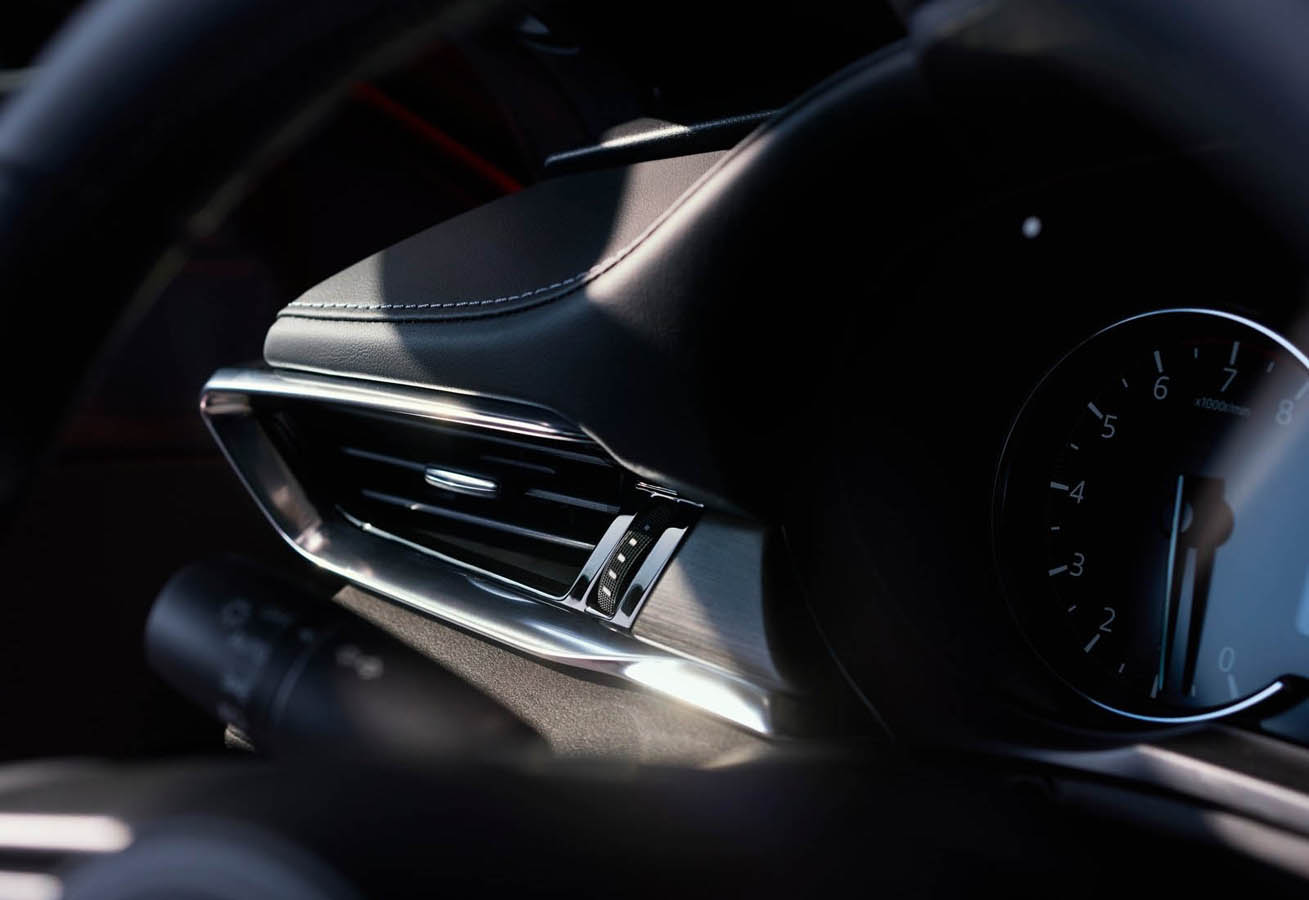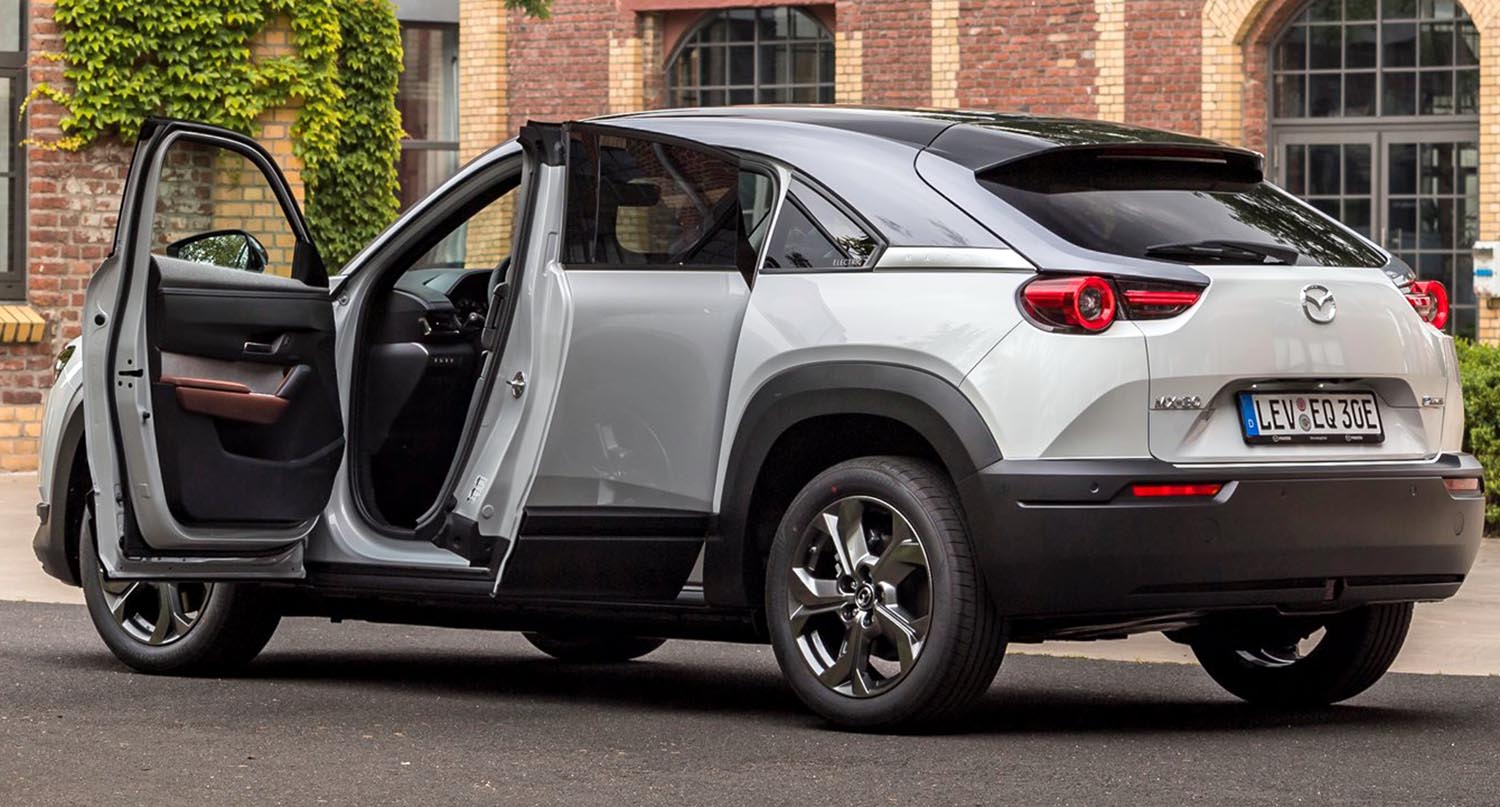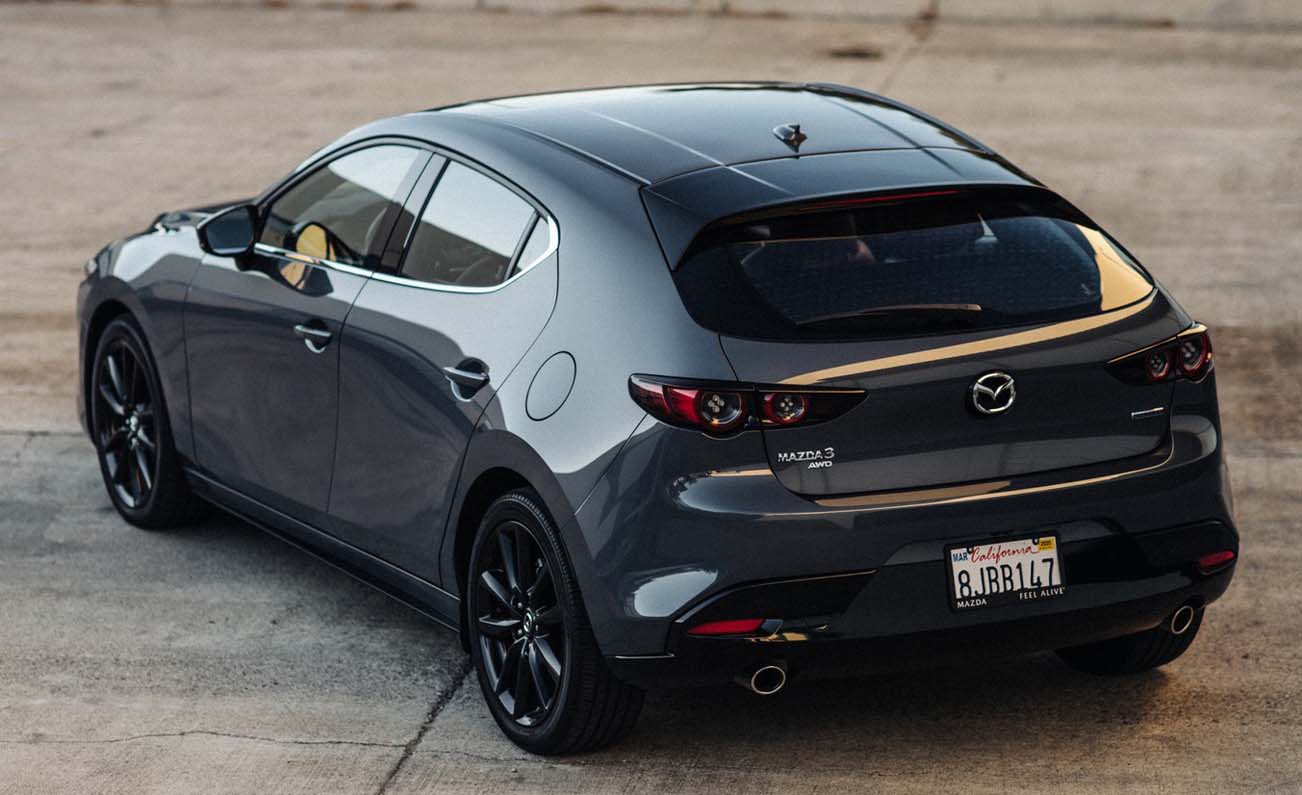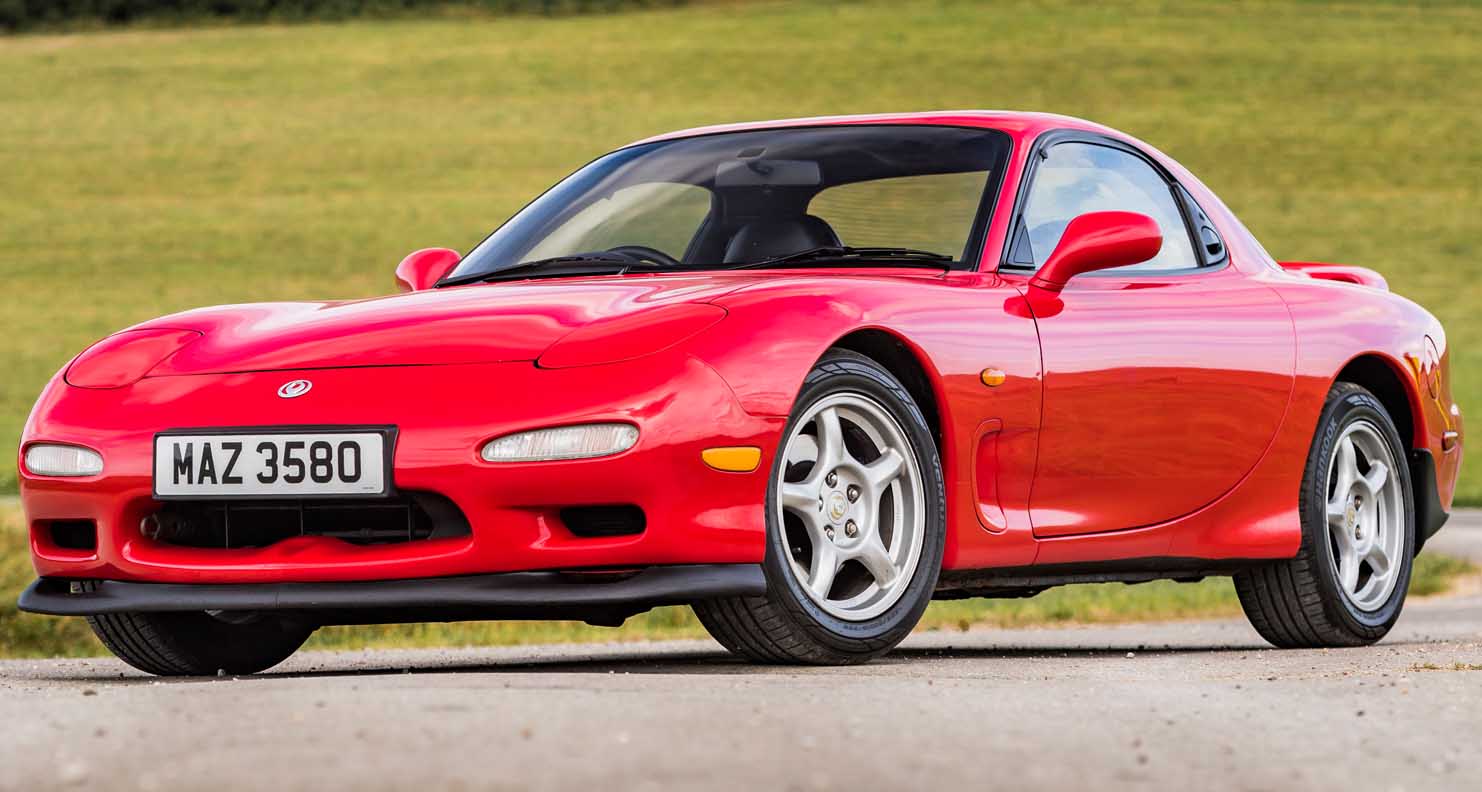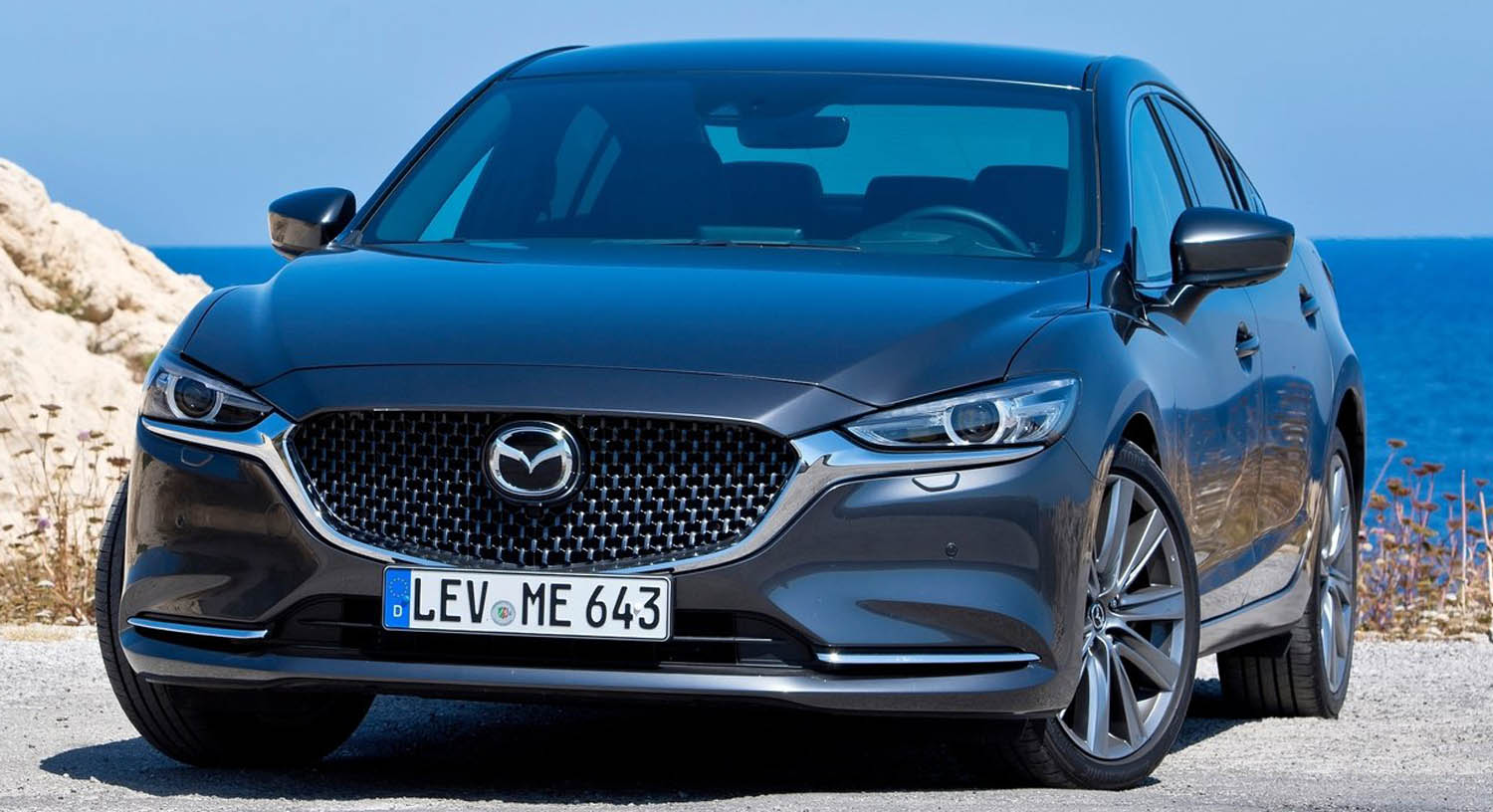
The latest update to the new Mazda 6 Sedan and Wagon is the most comprehensive yet, offering enhanced quality in almost every detail of Mazda’s flagship model.
It features a more mature, elegant and refined exterior design, and extensive interior revisions including completely new front and rear seating, premium quality trim and finish detailing throughout and, for models equipped with the MZD Connect multimedia system, the availability of Apple Car Play and Android Auto .
New technologies boost the performance of all SKYACTIV powertrains, and driving dynamics have been enhanced through increased body rigidity, steering and suspension system revisions, greater aerodynamic efficiency and reduced NVH (Noise, Vibration and Harshness).
Safety has also been improved, the New Mazda 6 offering an even wider range of driver support systems through the adoption of advanced i-ACTIVSENSE safety features such as Mazda Radar Cruise Control with Stop & Go, and a 360° View Monitor.
DESIGN
Every aspect of the new Mazda 6’s KODO – Soul of Motion exterior and interior design has been driven by a ‘Mature Elegance’ development concept, elevating its overall presentation to the pinnacle of quality and refinement appropriate to the flagship of the Mazda brand.
The exterior design further accentuates the essential elegance of the Mazda 6. Features such as the new front grille contribute to an image of powerful motion that flows from front to rear, the settled, stable nature of a low center of gravity, and a more refined look of dignified beauty.
On board, the new Mazda 6’s driving environment has been further evolved and refined based on the company’s human-centered design philosophy. Major changes to areas such as the instrument panel and door trim create an elegant atmosphere within the cabin. The front and rear seats provide greater comfort and a more natural posture, and the instrumentation has been made easier to read.
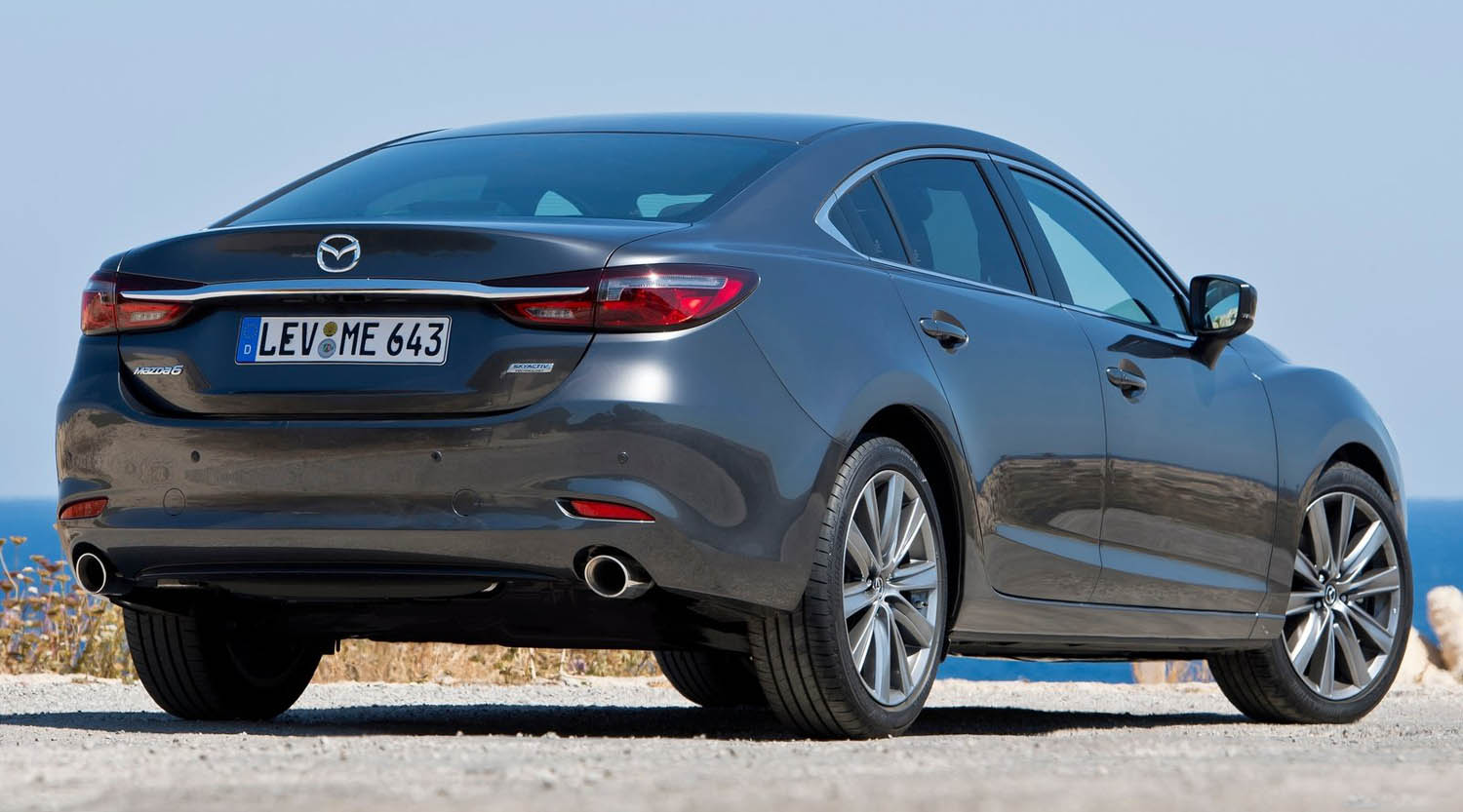
EXTERIOR DESIGN
A new frontal design adopts a more powerful, deeply sculpted look accentuating horizontality, a low centre of gravity and a wider stance.
The grille’s bottom edge dips lower than before at its center, while the tips of the signature wings flow along the bottom of the headlamp assembly. The grille mesh is positioned deeper within the surround, and its design is a deeper, more intricate pattern of small blocks.
New headlamps adopt a sleek, wide shape. LED turn signals form a line along the upper edge of each headlamp unit, and the lighting signature design penetrates the projector, while edging the lower half of the headlamp unit. This enhances the look of the design when lit; the sharp form and lines of light producing a bold expression, while lighting the lower section of the headlamp housing to hint at the Mazda 6’s low center of gravity.
Integrating the fog lamp function into the headlamp units allows for a new, horizontally oriented bumper corner design which emphasises the Mazda 6’s wide front stance. Ducts introduced beneath the trim pieces contribute to improved aerodynamic performance by channeling air to the front tires.
To the rear, design of the previous Mazda 6 Wagon has been so well received by customers for its sporty good looks that it is carried over on the new model. However, on both wagon and sedan variants, the body colour now extends to the lower bumper section to present a tauter look of higher quality.
The sedan also benefits from several additional new styling features. A new rear combination lamp design features a sleek, sharp, well-balanced appearance. The brake lamp cylinders are positioned lower and, adopting a design similar to the headlamp units, the lighting signature edges the bottom of the lamp unit.
The rear-facing lower section of the trunk lid and the horizontal line of its extended garnish lend a refined air befitting a sedan. Concurrently, the exhaust pipes are now positioned closer to the outer edges and the pipe diameter is also increased.
The reduced gap between the pipes and the bumper accentuate the Mazda 6’s wide rear stance, giving the impression of a lower center of gravity and more powerful physique.
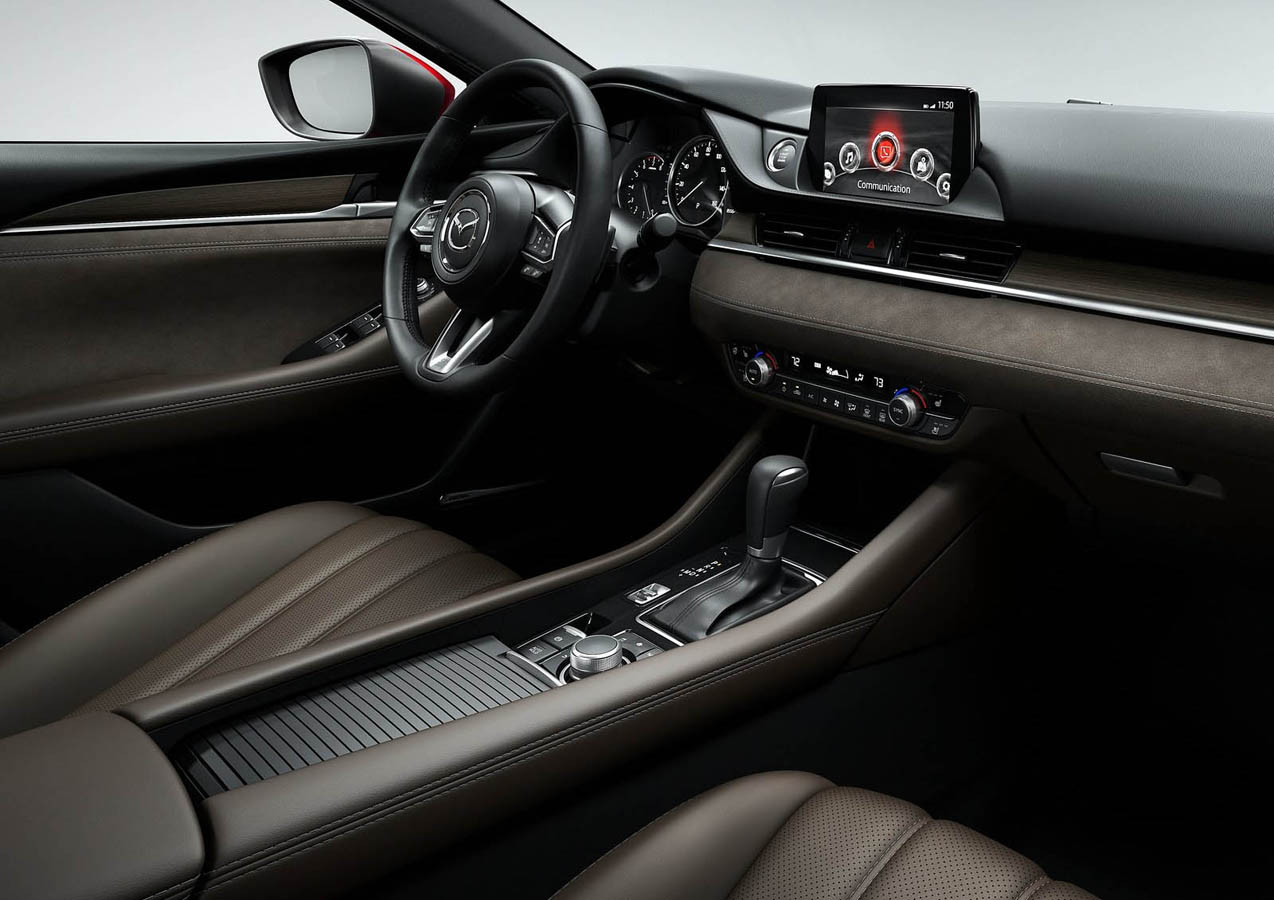
INTERIOR DESIGN
The new Mazda 6 interior design reflects Mazda’s commitment to enhance all visual and tactile elements, and bring a new sense of unification to the cabin architecture.
Based on the results of a quantitative study, the sun visor material has been changed and a new cushion structure adopted for the instrument panel’s middle pad, door trim and armrests, to achieve a softer touch.
The study also inspired work to improve the feel of opening and closing the glove box and rear console box lids, as well as operation of the ventilation louver control dials.
A further campaign to achieve ‘unification’ involved producing each part at a high level of quality and then assembling each unit with all parts and functions aligned in consistent fashion, whilst adjusting the color of different materials to match.
An enhanced level of comfort and satisfaction has been achieved by giving all components that surround cabin occupants -such as the door trim, the middle pad on the instrument panel, the floor console and center armrest- practically the same feeling to the touch.
Even the hue and brightness of the interior’s indirect lighting has been optimised, whilst new courtesy lamps mounted on the front and rear doors incorporate white puddle lamps positioned at foot level and rear-facing red warning lamps.
New to the range, Mazda’s highest quality interior package features the painstaking coordination of real Sen wood and other quality materials. The enhanced beauty and tactile quality of this new, premium interior package brings a newfound level of maturity and elegance to Mazda’s flagship model.
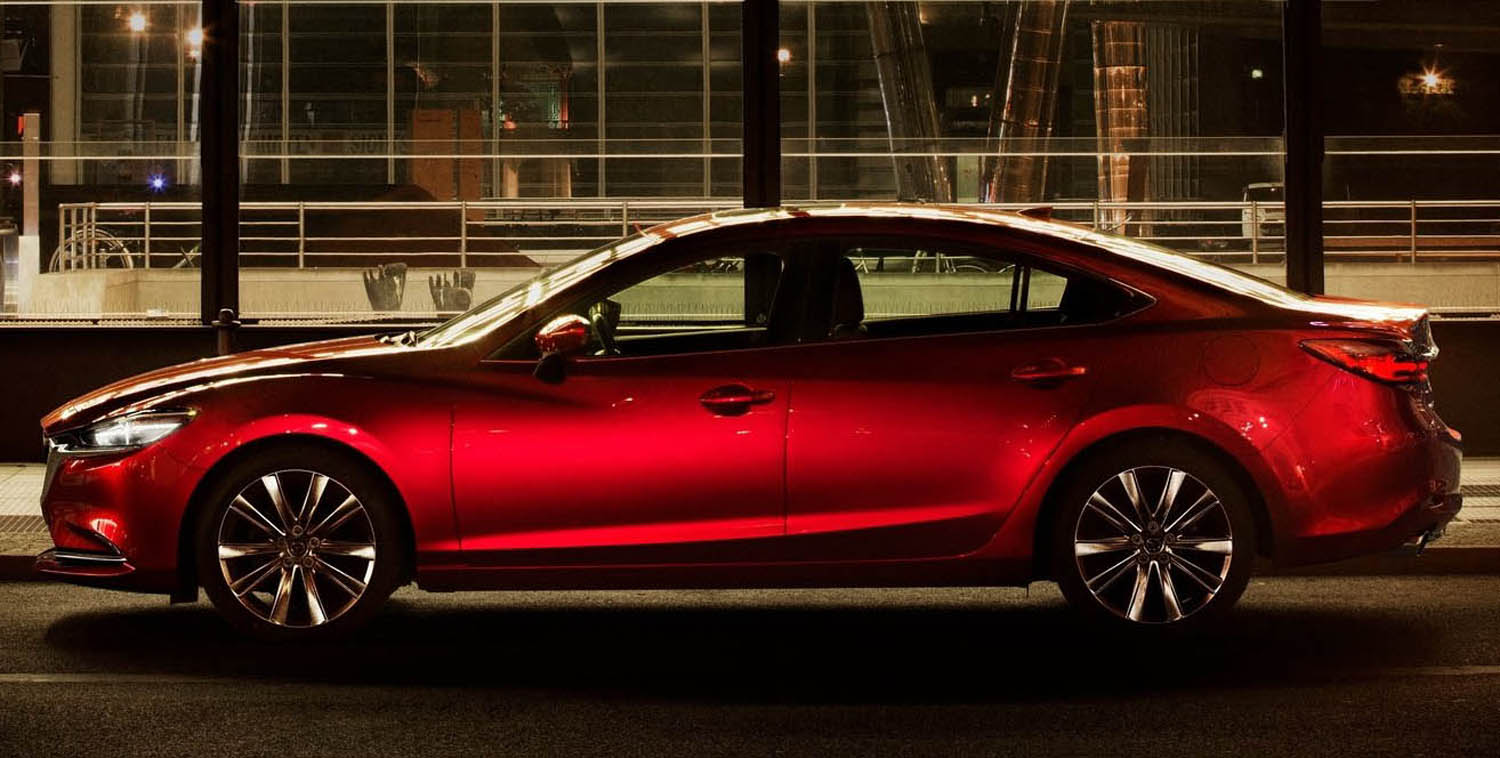
Instrument Panel and Door Trim
Further refinement of the instrument panel and door trim designs better highlights the breadth of the cabin. Matching the height of the centre and side ventilation louvres improves the lateral flow of the instrument panel’s design, enhancing the refined cleanliness of the cabin environment.
The side louvers are designed to extend into the door trim, making the instrument panel look all the wider and heightening the feeling of spaciousness. Adding greater depth to the decorative panel on the passenger side elevates the balance between feelings of being comfortably surrounded and of liberating openness.
Set at the same height as the elements on the instrument panel, matching decorative front and rear door trim elements run straight along the sides of the cabin, further enhancing the perception of continuity and quality throughout the interior space
Human Machine Interface (HMI) Meters and Active Driving Display
An eight-inch centre display positioned on top of the dashboard is the first of its size to be used on the Mazda 6. It establishes a balance with the wide feeling of the cabin, while enhancing operating ease and visibility.
High-grade models feature a seven-inch TFT LCD display located in the center of the driver’s instrument binnacle. A wide range of clear, easy to read vehicle status and multimedia system information may be selected, including the speed limit for Mazda Radar Cruise Control (MRCC) as a needle displayed on the analog speedometer dial .
The Mazda 6 features a new Active Driving Display that projects vehicle information directly onto the windscreen. Positioning the display above the meters minimizes the need for the driver to move their line of vision or adjust focus.
The displayed information is divided into upper and lower zones, with driving environment information displayed in the upper section, including turn-by-turn navigation and speed limit information . Vehicle status information, including current vehicle speed and advanced safety equipment information, is displayed in the lower section. The result is quicker and easier reading of pertinent data.
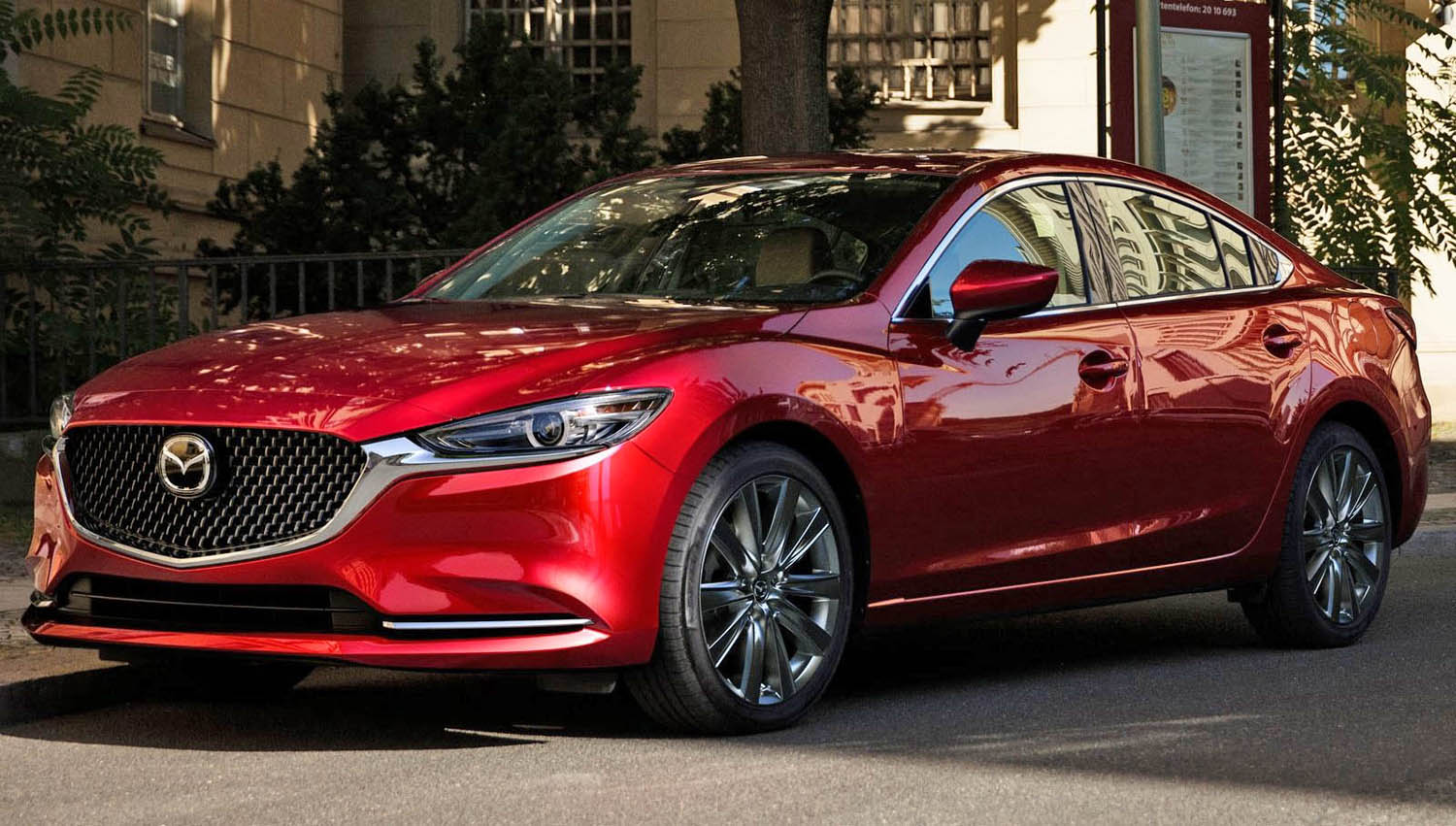
Apple Car Play and Android Auto
Depending on the European market, Apple Car Play and Android Auto will be available for Mazda 6 models equipped with the MZD Connect multimedia system in the beginning of August 2018.
Both software systems will also be available as a retrofit for all Mazda vehicles fitted with MZD Connect.
Seats
New Mazda 6 is fitted with leather upholstery are the first Mazdas to feature front seat ventilation. Offering three-stage control over ventilation strength, the system draws air in through ventilation ports in the seat cushions and expels it.
The rich depth and sculpted shape of the new seats are accentuated by the adoption of thicker padding and wider seat cushions, combining improved comfort with the quality befitting a flagship model.
The front seats have been completely redesigned with new, more supportive materials to combine ideal posture with superior comfort. Reshaped seatbacks adopt thicker urethane padding to enhance back support. The seat cushions feature high-resilience, high-vibration-absorbing urethane foam which remains soft enough to give under the occupant’s weight.
The side bolsters are larger and more pronounced, combining with an optimised cushion angle and support spring structure to firmly support the occupant’s pelvic region. The shape of the headrest has also changed to enhance its fitted feel.
The shape of the rear seats has been significantly changed. The seat cushions now adopt high-resilience, high-vibration-absorbing urethane foam. Changes to the fore-aft positioning of the headrests and seat cushion angle combine with a center armrest that is positioned at the same height as the door armrests to further enhance comfort and support.
In addition to cupholders, the rear center armrest now features a new, lidded storage compartment. A pair of USB ports inside the compartment lets occupants charge their portable devices.
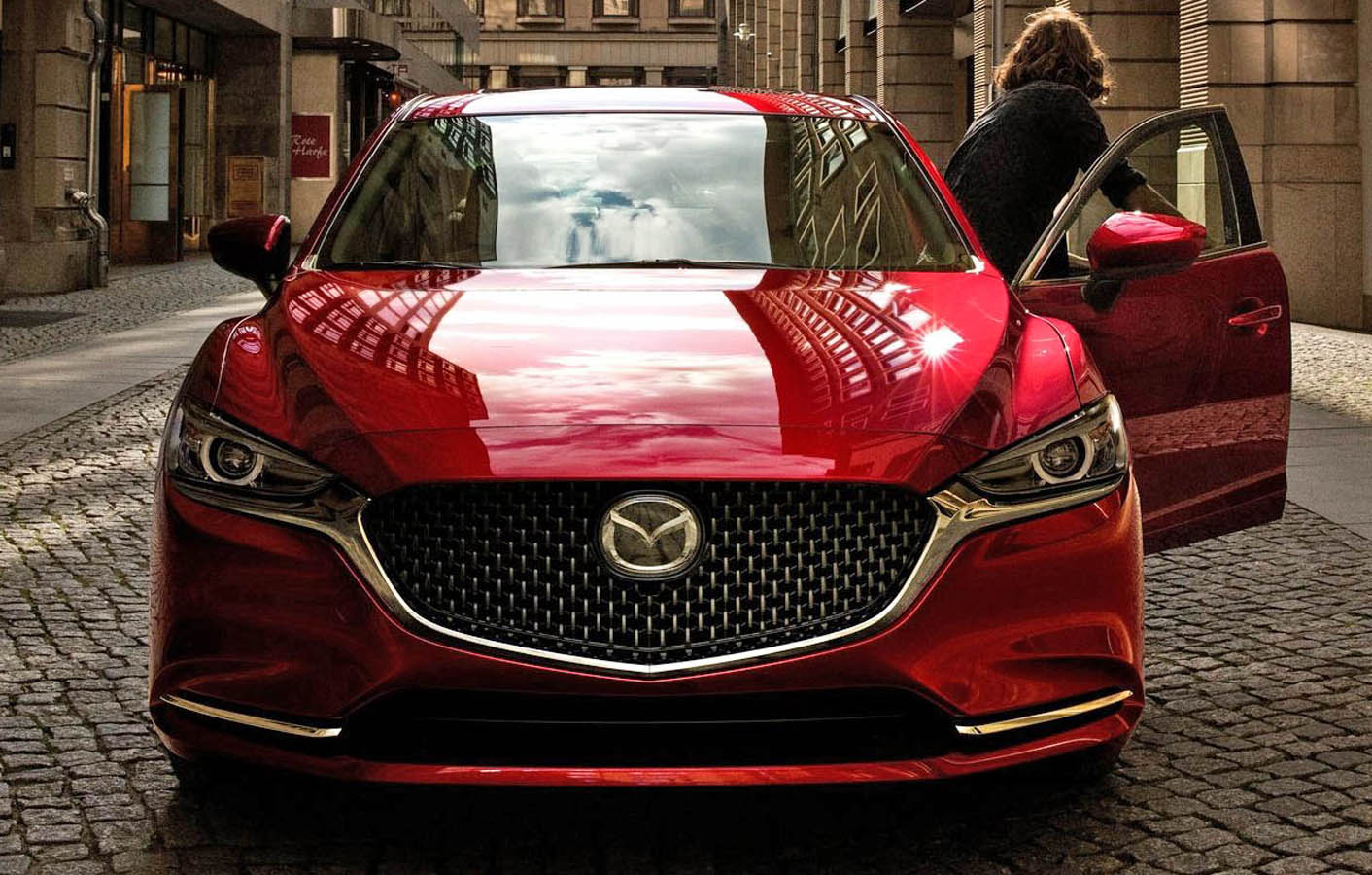
Interior Colours
The new Mazda 6 interior is available with a choice of Pure White or Black leather upholstery, as well as a Black colour scheme featuring fabric material.
A hair-line finish aluminum film layered over a sculpted acrylic base material is used on the instrument panel and door trims. These premium quality decorative elements add richness and material depth.
Mazda’s Highest Quality Interior Package
The new Mazda 6 may be equipped with the brand’s highest quality interior package. Employing the finest materials and complimented by unique colour coordination, features include Nappa leather seats, real wood trim and suede-finish materials.
The Nappa leather seats feature a soft touch and rich finish. Satin chrome trim etches a line across the face of the seatbacks at the same height as the decorative elements on the instrument panel and doors. Solid rear seatback panels are trimmed with satin chrome, and the control panels for the power front seats adopt piano black bezels and chrome-plated switchgear.
These combine with the high-quality seat materials to significantly enhance perceived quality within the cabin.
Blending warmth and modernity, the instrument panel and door trim is fabricated in Japanese Sen, a type of wood often used for traditional Japanese furniture and musical instruments, while the ventilation louver bezels are finished in piano black.
In addition, the instrument panel central pad features Ultrasuede® NU, a new material by Toray Industries Inc. The new Mazda 6 is the first production car in the world to introduce this material, which represents a fusion of the latest industrial technology and traditional Japanese craftwork techniques.
This range-topping interior package is available in a new Oriental Brown colour scheme. Oriental Brown is modeled on the wooden pillars of ancient Japanese temples that have been lovingly maintained over the centuries.
The interior colour scheme is two-tone, with black used as the base colour for the ceiling and pillars. The interior’s dark wood tones dissolve into the black base colour, while the Nappa leather and suede create variations in tones.
This layering of similar hues produces a tone-on-tone effect.
Finally, satin chrome trim unifies and colour-coordinates the interior, lending the cabin a mature and elegant air.
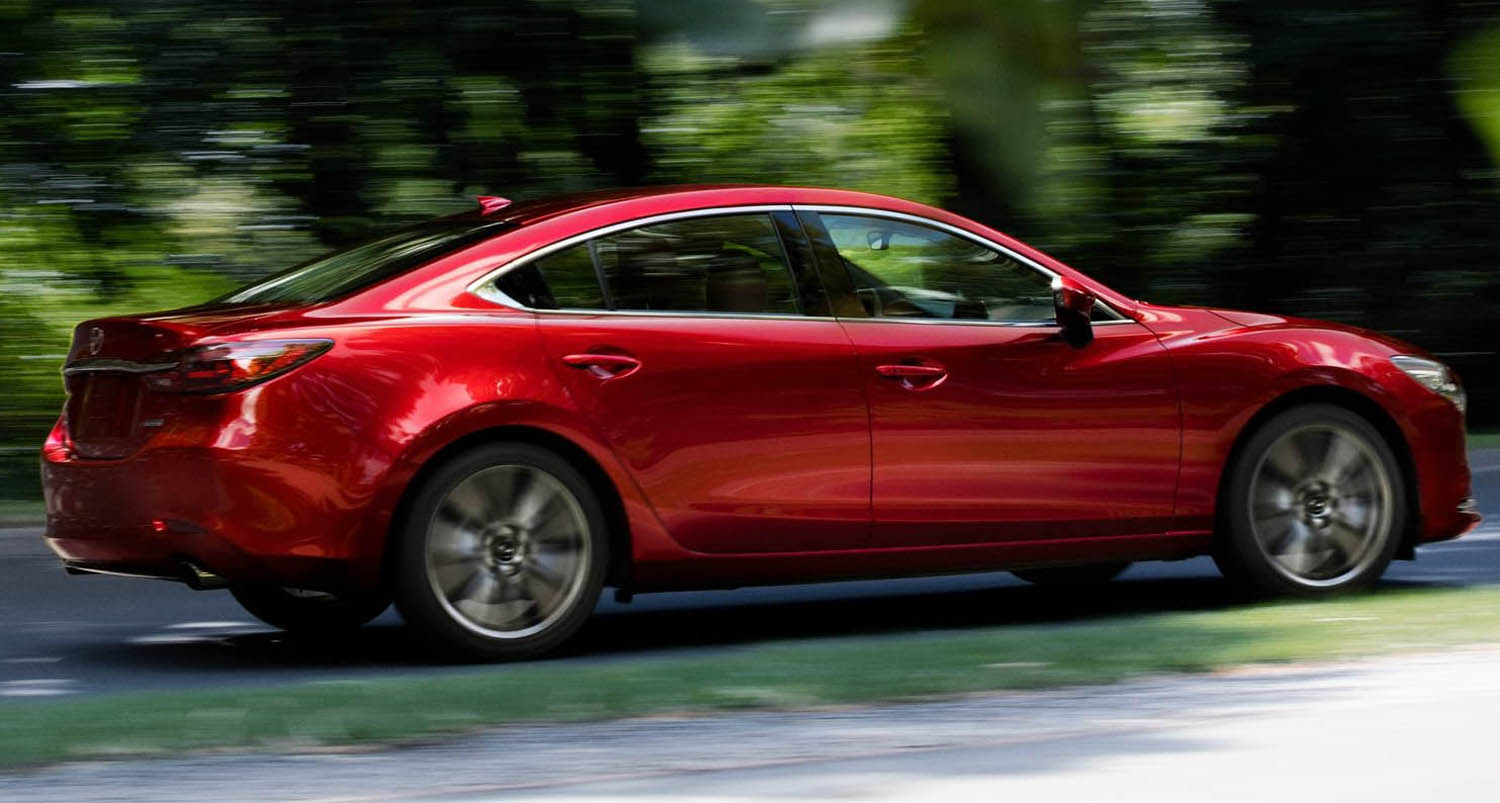
SKYACTIV POWERTRAINS
The new Mazda 6 will be available throughout Europe with a choice of five engines: 145 PS and 165PS versions of the SKYACTIV-G 2.0 litre petrol engine, a 194 PS SKYACTIV-G 2.5 litre petrol engine with cylinder deactivation, and both 150 PS and 184 PS variants of Mazda’s SKYACTIV-D 2.2 litre turbodiesel.
All engines are homologated according to the requirements of the new WLTP/RDE test cycle, and meet Euro 6d temp emissions regulations.
They may all be mated to a choice of six-speed manual or six-speed automatic transmissions, with the exception of the SKYACTIV-G 2.5 and the 184 PS SKYACTIV-D 2.2 AWD, which are only available with automatic transmission.
SKYACTIV-G 2.0 and 2.5 units all feature front-wheel drive powertrains, whilst SKYACTIV-D 2.2 variants may be equipped with both front- and all-wheel drive (for Wagon only).
Equipped with Mazda’s i-stop and i-ELOOP systems , the engine in the line-up benefit from the introduction of new technologies to enhance performance and boost torque at low rpm for faster throttle response from a standstill. This enables the driver to easily sense subtle changes in acceleration when operating the accelerator pedal slowly, offering more precise control to strengthen the connection between car and driver.
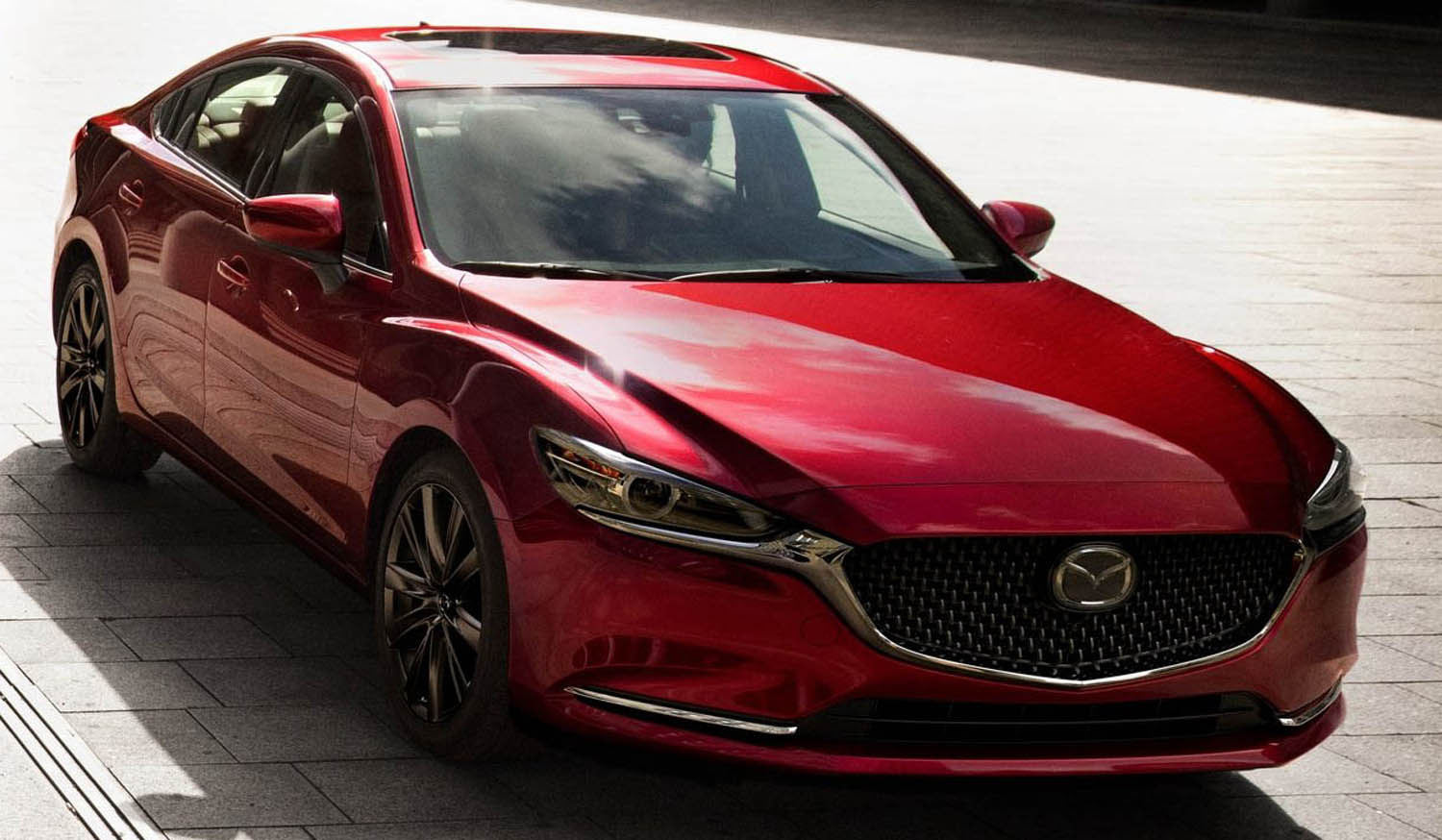
SKYACTIV-G 2.0
The 2.0-liter engine offers an ideal balance of excellent fuel efficiency and spirited driving thanks to powerful low- to mid-range torque.
The updated engine’s intake ports have been redesigned, a new piston shape adopted, and the compression ratio raised to 13.0:1. The nozzle of the multi-hole injectors has been redesigned and fuel spray pressure increased. A coolant control valve makes warming the engine more efficient, and asymmetrical oil rings in conjunction with barrel-shaped piston skirts reduce mechanical friction.
These changes increase low-end torque by 6.2%, while also reducing real-world fuel consumption and particulate matter formation during combustion.
The result is enhanced dynamic performance, fuel economy, and environmental friendliness. Emissions easily comply with new WLTP/RDE test cycles, falling well within the particle number limits without the need for a petrol particle filter.
The lower powered 1,998 cc unit develops 145 PS at 6000 rpm and maximum torque of 213 Nm at 4000 rpm. It combines an average fuel consumption of 6.2-6.3 l/100 km and CO2 emissions of 141-144 g/km.
The higher powered unit of the same capacity develops 165 PS at 6000 rpm and maximum torque of 213 Nm at 4000 rpm. Its average fuel consumption is 6.1-6.6 l/100 km, CO2 emissions are 139-150 g/km.
SKYACTIV-G 2.5
With a high 13.0:1 compression ratio, the reduced weight of an aluminum-alloy cylinder block, and a balancer unit that reduces low frequency rattling, the 2.5 litre engine achieves high levels of dynamic performance, fuel economy and quietness.
The new version of the engine adopts the same technology updates as the SKYACTIV-G 2.0. In addition, a new cylinder deactivation system is available, further reducing fuel consumption when driving at constant speed of 80 km/h.
The 2,488 cc unit develops 194 PS at 6000 rpm and maximum torque of 258 Nm at 4000 rpm. It combines an average fuel consumption of 6.7-6.8 l/100 km and CO2 emissions of 153-156 g/km.
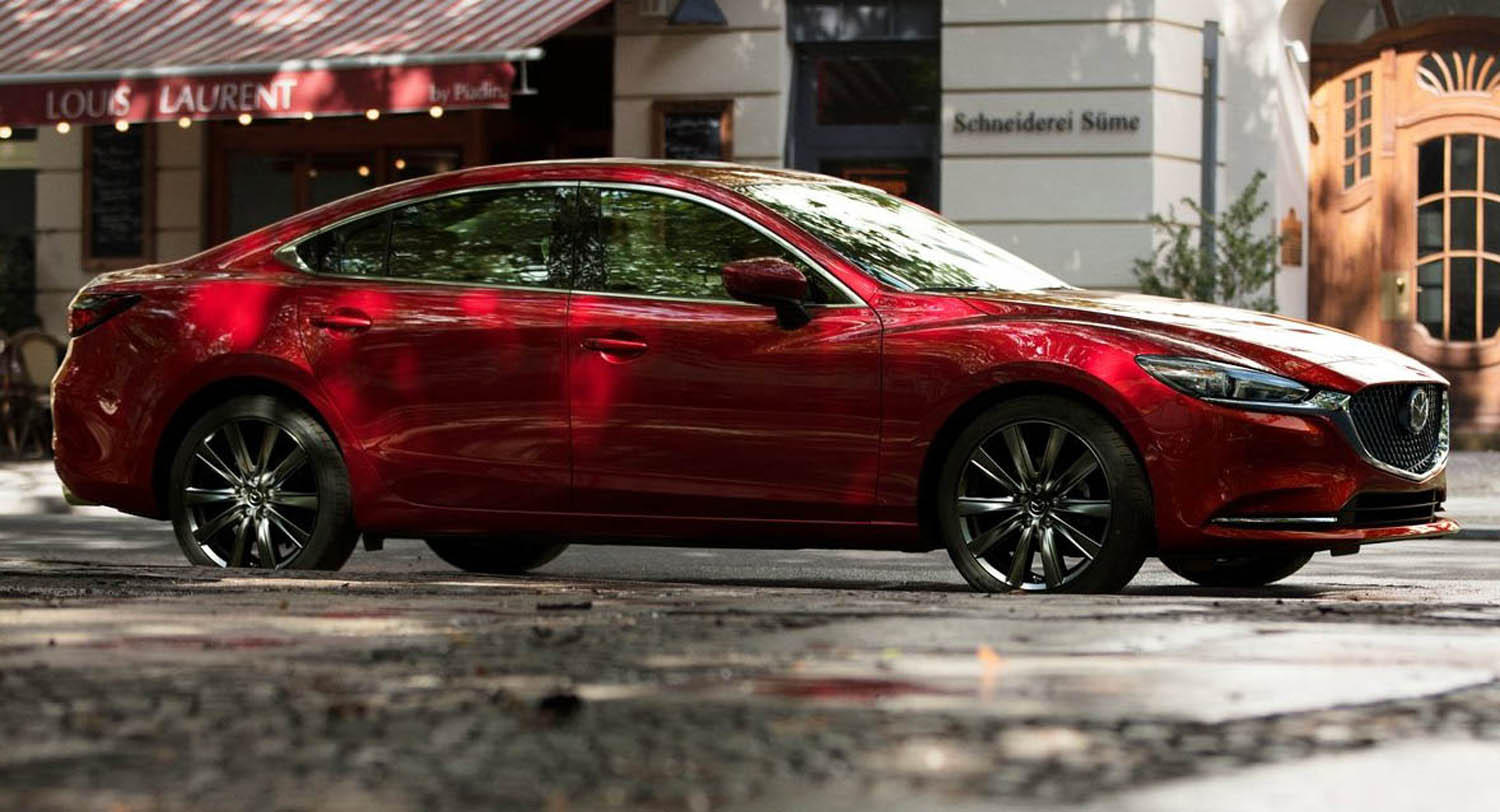
INNOVATIVE SKYACTIV-G PETROL ENGINE TECHNOLOGIES
Precision manufsactured intake ports and a new piston shape: The shape of the intake ports has been carefully crafted to generate a stronger tumble flow during intake. Reducing the height of the piston crowns while optimizing their shape also strengthens tumble flow during the compression stroke and increases turbulence at the time of ignition.
These factors cause the flame to spread faster from the spark plug and combustion is completed more quickly without knocking (irregular combustion). The result is greater torque at low- to mid-range rpm and improved fuel economy at higher rpm.
More efficient fuel injection: The nozzles of the multi-hole fuel injectors were redesigned and fuel pressure increased from 20MPa to 30MPa to realize a faster and more broadly dispersed spray. Fuel is thoroughly vaporized before it adheres to the walls of the cylinder, realizing efficient, waste-free combustion.
Three-stage split fuel injection is used when the engine is cold and combustion is more likely to produce particulate matter. This improves vaporization and atomization of the fuel and reduces particulate matter formation by approximately 80 percent. The result is excellent environmental performance that conforms to European particulate number regulations that came into effect in 2017.
Coolant control system: A new Coolant Control Valve helps prevent heat from escaping while the engine warms up by reducing the flow of coolant around the walls of the combustion chamber to a trickle. Larger amounts of fuel must be injected when the engine is first started because gasoline vaporises less readily in cold temperatures.
Adopting the new coolant control system helps the engine to warm up quickly and cuts the necessary fuel increase to half that of the previous SKYACTIV-G 2.5 engine, contributing to improved real-world fuel economy.
Optimized oil ring and piston skirt shapes: New asymmetrical oil rings feature a larger outer radius at the top and a smaller radius at the bottom edge. This optimises the thickness of the oil film on the wall of the cylinder as the piston rises and falls, reducing mechanical resistance.
Revised piston skirt curvature realises an ideal barrel shape. The new skirts combine with the asymmetrical oil rings to significantly reduce mechanical resistance, contributing to better fuel economy.
Cylinder deactivation (SKYACTIV-G 2.5 only): The system shuts down two of the engine’s four cylinders in light-load situations, such as when cruising at a constant speed.
Running on two cylinders reduces pumping loss and mechanical resistance. Cylinder deactivation is more effective at low speeds, improving fuel economy when driving at a constant 80km/h.
Variable displacement oil pump: The new oil pump supplies the optimum amount of oil to the engine in relation to the engine speed and load at any given time. It uses a hydraulic sensor to monitor the engine for linear control of the solenoid valve to continuously change the amount of oil output by the pump. The supply of oil is therefore reduced at rpms where the engine does not require it, and this reduces mechanical resistance.
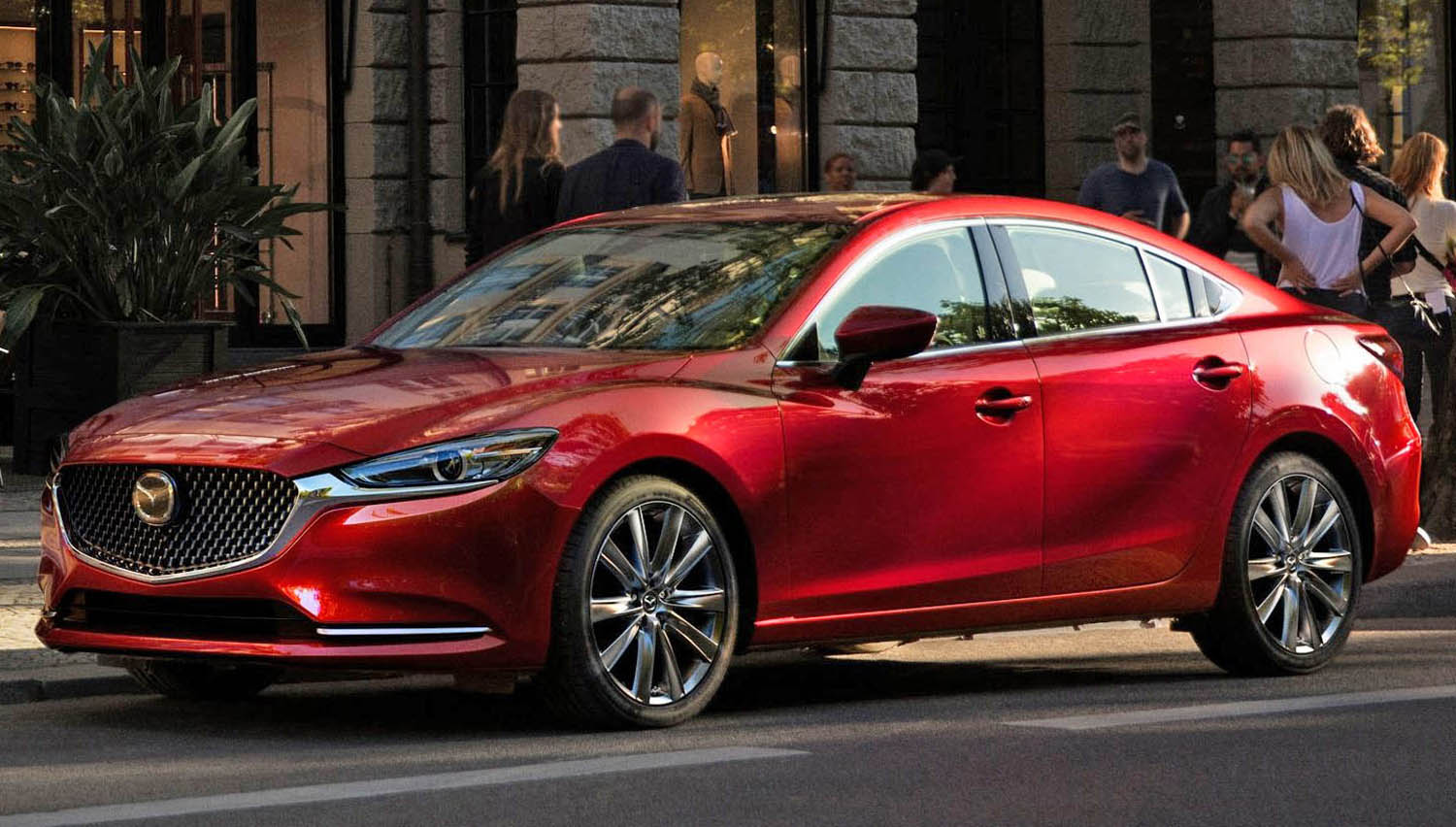
SKYACTIV-D 2.2 DIESEL ENGINE WITH TWO-STAGE TWIN TURBOCHARGER
The SKYACTIV-D 2.2 is a clean diesel engine that delivers outstanding torque and dynamic performance with quick response right through to high rpm, as well as excellent fuel economy and environmental performance.
New technologies are aimed at reducing harmful emissions, realising a more robust driving experience, and delivering a quieter ride.
The SKYACTIV-D 2.2 is also equipped with a urea Selective Catalytic Reduction (SCR) system that significantly reduces NOx emissions. This enables it to achieve an excellent level of environmental performance and comply with strict European emissions regulations (EURO6d-temp).
Its compression ratio raised from 14.0:1 to 14.4:1, the updated engine adopts Rapid Multi-stage Combustion, taking Mazda one step closer to its goal of ideal combustion. A new design for the stepped, egg-shaped pistons combines with ultra-high-response multi-hole piezo injectors to increase combustion efficiency.
Sodium filled exhaust valves enhance heat transfer and coolant control valves improve engine warm-up efficiency to help achieve better real-world fuel economy.
Moreover, a new two-stage twin turbocharger with variable turbine geometry helps increase maximum output from 129 kW to 135 kW and maximum torque from 420 Nm to 445 Nm, resulting in even smoother and more powerful performance.
The precise control delivered by High-Precision DE Boost Control over torque response in reaction to accelerator pedal operation realizes performance that matches the driver’s intentions and heightens the connection between the driver and car.
In addition, Natural Sound Smoother and Natural Sound Frequency Control are both further evolved to deliver an even quieter ride with a more pleasing engine note.
The lower powered 2,191 cc unit develops 150 PS at 4500 rpm and maximum torque of 380 Nm from 1800-2600 rpm. It combines an average fuel consumption of 4.4-5.4 l/100 km and CO2 emissions of 117-142 g/km.
The higher powered unit of the same capacity develops 184 PS at 4000 rpm and maximum torque of 445 Nm at 2000 rpm. Its average fuel consumption is 4.7-5.4 l/100 km, CO2 emissions are 124-142 g/km.
Selective Catalytic Reduction (SCR) system: The new (SCR) system meets the stricter emission limits of EURO 6d Temp. It operates continuously, reducing NOx emissions using diesel exhaust fluid like AdBlue; a urea solution injected into the exhaust stream which causes a chemical reaction that converts up to 90% of the NOx in the exhaust into innocuous nitrogen and water. The system realizes outstanding environmental performance without sacrificing driving pleasure.
Rapid Multi-stage Combustion: The updated SKYACTIV-D 2.2 features a new combustion process called Rapid Multi-stage Combustion. Multiple, high-pressure fuel injections (up to six) in quick succession generate a continuous burn with a shorter combustion period.
This new combustion method results in quieter and more economical performance during low-speed, low-load city driving, but produces a linear engine sound that matches the degree of acceleration.
Redesigned combustion chamber: The shape of the combustion chamber has been optimized to prevent fire from clinging to the piston and minimize energy loss by heat transfer to the wall.
Ultra-high-response multi-hole piezo injectors: Ultra-high-response injectors that emit fuel spray from 10 separate injection ports enable a multi-stage main injection and a faster post-combustion injection, shortening the combustion period. Pressure sensors integrated into each injector allow for more accurate fuel injection and work in combination with the new stepped, eggshell piston shape to make combustion more efficient.
Sodium-filled exhaust valves: In line with the increased power output, valves hollowed from head to stem and filled with sodium are adopted for improved heat-resistance and more effective heat transfer.
Variable turbine geometry turbocharger: The two-stage turbocharger uses a smaller or larger turbine or both depending on engine speed. The larger turbine now adopts a variable geometry design that delivers boost more quickly at lower engine speeds. This increases boost efficiency throughout the engine’s operating range, increasing maximum power and torque and realizing smoother, more powerful dynamic performance.
Coolant control system: A new Coolant Control Valve helps prevents heat from escaping while the engine warms up, by reducing the flow of coolant around the walls of the combustion chamber to a trickle. Rapidly warming the area around the combustion chamber improves ignition and promotes vaporization of the fuel. It also makes the oil less viscous, reducing mechanical resistance. Improved heating performance helps reduce fuel consumption, improving real-world fuel economy.
High-Precision DE Boost Control: High-Precision DE Boost Control effects more precise control of engine torque response by optimizing boost pressure control and enabling finer adjustment of fuel injection. The engine responds instantly and precisely to accelerator pedal operation under light-load conditions, offering performance that matches the driver’s intentions and strengthens the connection between the driver and car.
Natural Sound Smoother and Natural Sound Frequency Control: The Natural Sound Smoother uses a dynamic damper in each piston pin to minimise piston vibration and reduce engine knock. Natural Sound Frequency Control modulates injection and combustion timing in 0.1ms increments, thereby overlapping the frequency valleys of combustion vibration with the peak frequencies of resonating parts to cancel out the vibration of each and further reduce knock.
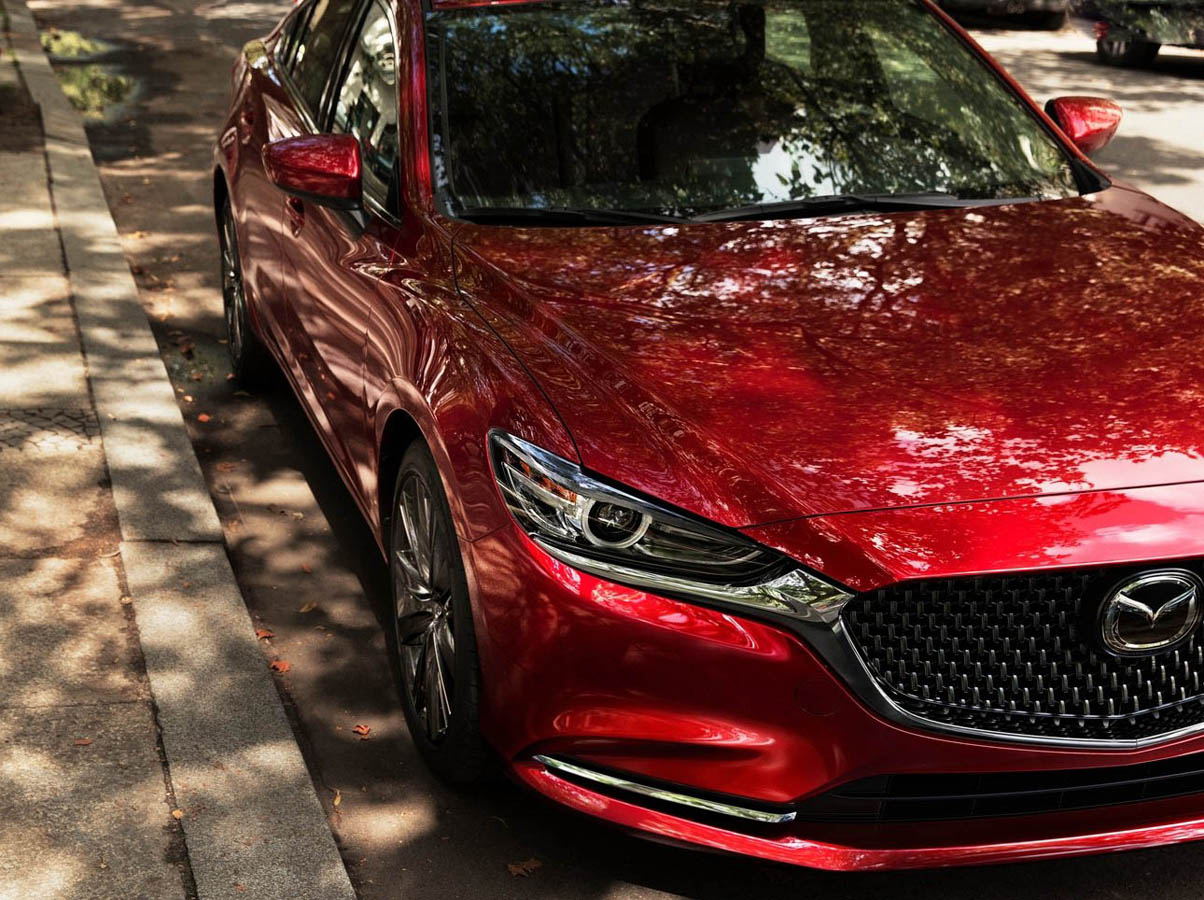
i-ELOOP and i-stop
Short for “Intelligent Energy Loop”, i-ELOOP is a pioneering system that stores recovered electricity in an advanced capacitor rather than employing a dedicated battery. The large-capacity electric double-layer capacitor (EDLC) captures and stores energy very quickly during the deceleration phase, which typically lasts only 10 seconds. Used to run the vehicle’s electrical systems,
i-ELOOP can improve real-world fuel economy by up to 10% depending on driving conditions.
The i-stop idle-stop system uses combustion energy for restarting the engine, and only requires an electric-powered starter motor to provide a small degree of momentum during the initial restart phase.
DRIVING DYNAMICS
In conjunction with the comprehensive enhancements to its engine line-up, the new Mazda 6 also benefits from carefully considered refinements to the chassis, body and NVH performance. These measures have resulted in more linear steering behaviour, greater ride comfort and outstanding cabin quietness.
SKYACTIV-CHASSIS
The front MacPherson strut and rear multi-link suspension systems have been significantly improved to greatly enhance chassis performance. As a result, the Mazda 6 now demonstrates smoother, more linear vehicle behavior and enhanced ride quality in both urban and open road environments.
The front steering knuckles were lowered for more neutral steering characteristics, while the mount of the lower arm was raised. The front and rear stabilizers are bonded to the mount bushings and the way load is applied to the front springs has been optimised, giving the suspension a smoother stroke.
The bump stop characteristics have been revised to extend the suspension’s linear stroke range, achieving smoother more stable roll characteristics. Rebound springs were also added to the front dampers.
Measures to improve ride comfort include an increase in the diameter of the front damper cylinders from 32 mm to 35 mm, and a change in the valve structure of the front and rear dampers.
To lower the spring rate characteristics and absorb even minor vibrations in the rear suspension, the new Mazda 6 is the first Mazda vehicle to use urethane for the rear damper top mount. This new layout demonstrates linear damping force in response to even small degrees of input, while also firmly suppressing skipping under high input to realise a higher level of ride comfort.
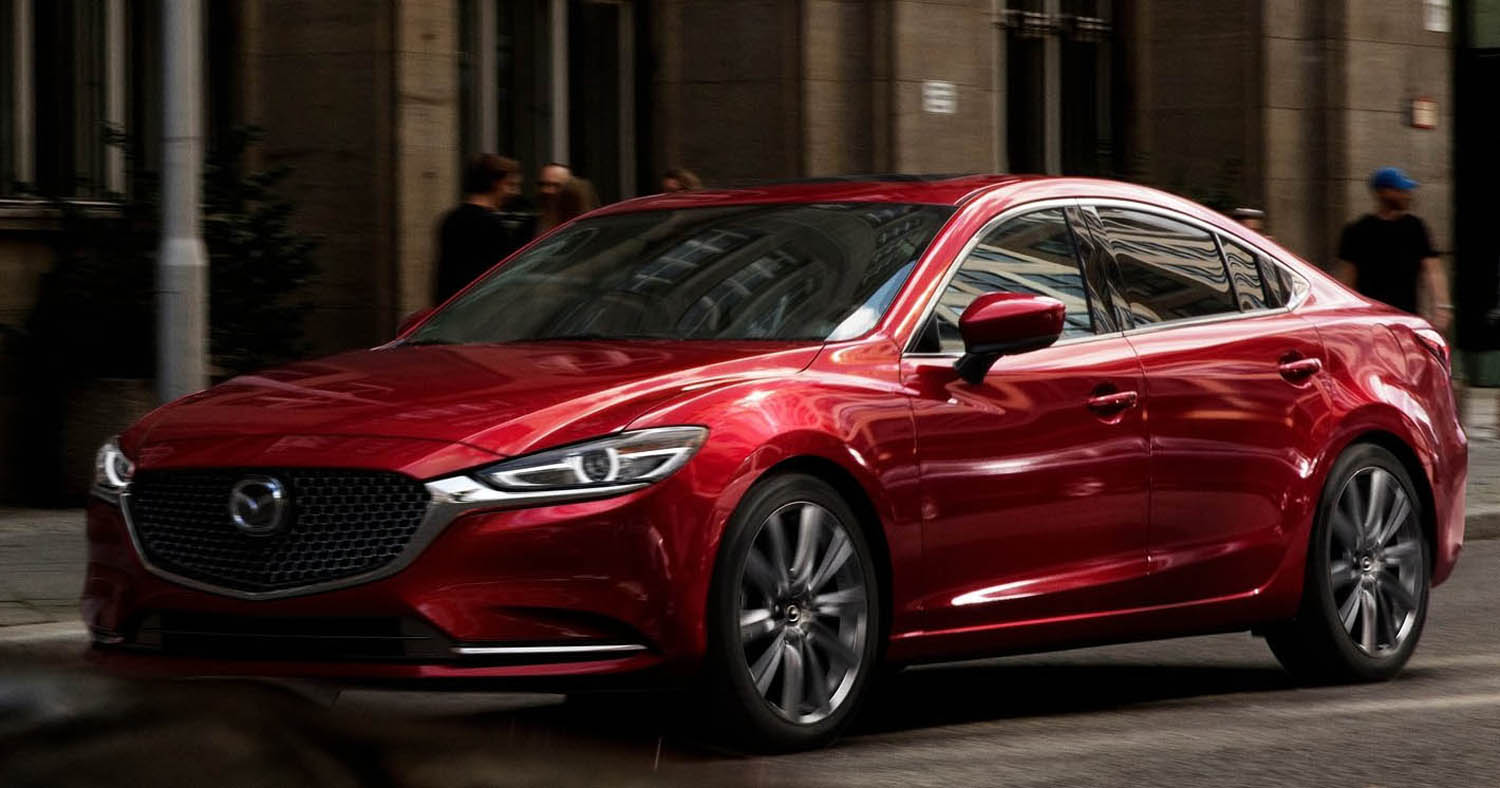
Steering system
Rigid mounts now attach the steering gear to the suspension cross-member, delivering more precise response to subtle steering wheel action when cornering or driving at high speeds. The increase in system rigidity combines with the enhanced suspension system to offer a more neutral, linear steering feel.
Brake system
In conjunction with the increased horsepower and torque output of the SKYACTIV-D 2.2 engine, diesel-powered versions of the updated Mazda 6 are fitted with larger, 320 mm diameter front brakes.
Auto-hold
Mazda’s Auto-hold function adds extra convenience when driving in stop-and-go traffic by keeping the car stopped even after the driver lifts his or her foot off the brake pedal. The brakes are released once the driver presses the accelerator pedal and the car starts off normally. The function can be turned on or off using a switch mounted on the floor console.
SKYACTIV-BODY
By increasing the rigidity of the model’s already highly rigid body while minimising weight increases through the careful design of structures and selection of materials, the distinctive ride comfort and cabin quietness of the Mazda 6 has been further enhanced.
The cowl cross-member has been thickened and the number of joints for each suspension top increased from one to two. This increases rigidity and strength between the front suspension tops. The cowl adopts an S-shaped cross-section structure that increases body rigidity and pedestrian protection performance, while also reducing weight.
The tunnel members were made larger and the number of joints securing each increased from three to four. This combines with the increased thickness of the left and right floor panels to significantly enhance rigidity.
To the rear, the thickness of the inner walls of the wheel housings has been increased. This combines with closed cross-section structure braces to realise an even stronger joining structure. In addition, the gussets for the rear suspension trailing link mounts have been thickened for greater strength.

Reduced NVH
NVH reduction efforts focused on reducing road noise and achieving conversational clarity to provide a refined cabin environment in which voices can be heard clearly.
Thicker floor panels and rear wheel housing inner walls greatly reduce the amount of tire noise that penetrates the cabin. Gaps between body panels or interior materials, as well as the number of holes in them, have been reduced.
Other measures implemented include a redesigned tire structure, increased suspension rigidity, and the addition of vibration-absorbing materials on the center tunnel.
The internal structure of the ceiling -the largest surface area in the cabin- has been changed, significantly improve its noise absorbing and damping characteristics, including the deadening of sound generated when a door is shut.
Aerodynamic Performance
Smoother, flatter shapes adopted for the engine and the center floor undercovers streamline the flow of air that passes under the floor. The shapes of the front tire deflectors and mudguards have been optimised, and covers newly adopted below the lateral links and rear bumper.
Low level ducts create a flow of air to the front tires which improves aerodynamic performance and greatly enhances high speed stability.
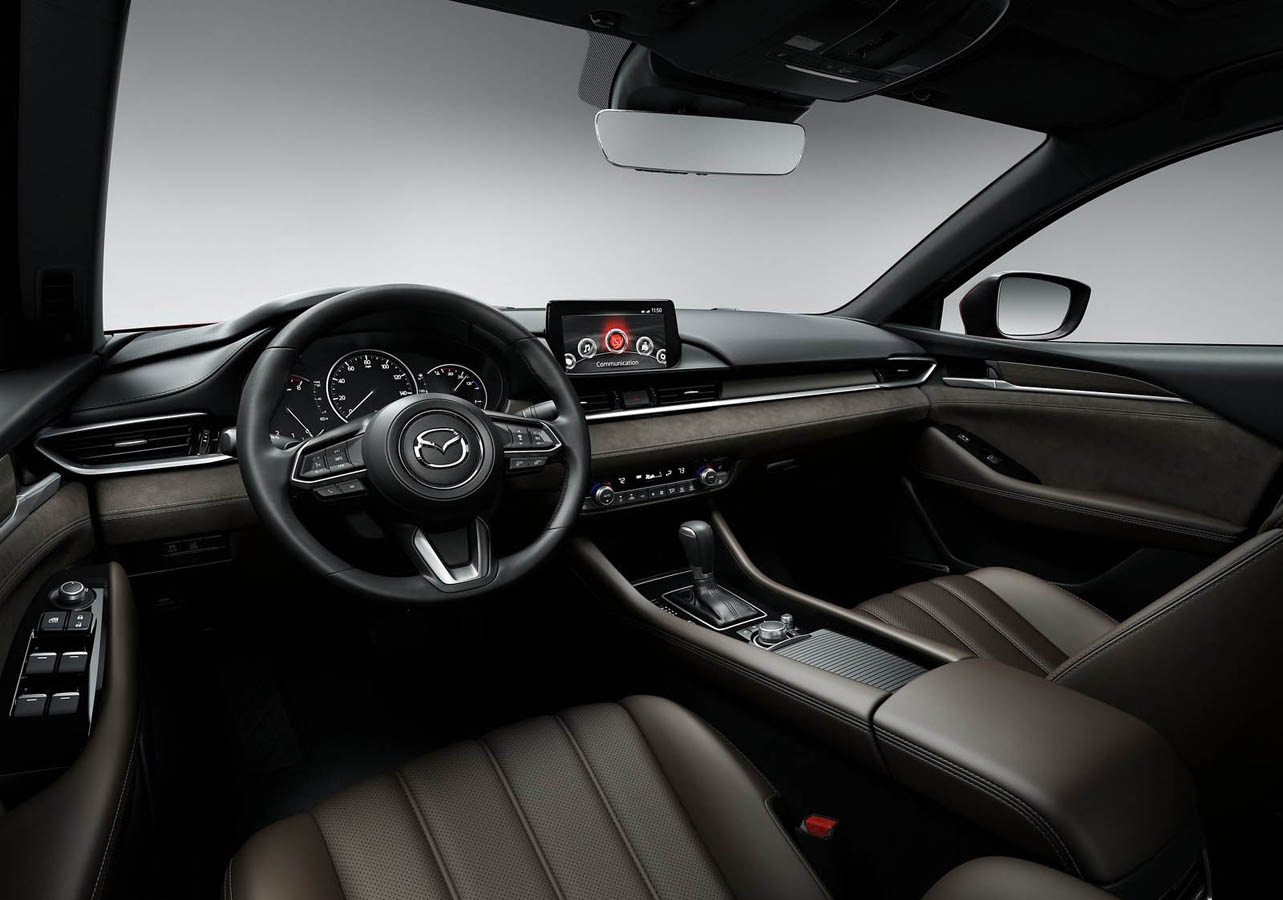
SAFETY
The new Mazda 6 features a wider range of advanced i-ACTIVSENSE safety technologies which help drivers identify potential risks and reduce the likelihood of damage or injury.
The functionality of the Adaptive LED Headlights has been enhanced and Mazda Radar Cruise Control now tracks the car in front at all speeds, even bringing the car to a complete stop in traffic. In addition, the model adopts Mazda’s latest 360° View Monitor.
Heating elements newly added to the windshield where the wipers rest helps ensure their free movement soon after starting the car in freezing climates.
In combination with previously introduced safety features, these technologies allow drivers to enjoy superior safety and worry-free driving under an even wider variety of conditions.
Adaptive LED Headlights (ALH)
ALH is incorporates the following features: Auto-controlled Glare-free High Beams, Wide-range Low Beams that illuminate a wider area, and Highway Mode, which automatically raises the headlamp beams when driving at high speeds.
Each headlamp’s array of LEDs has been now been divided more finely into 20 blocks that can be independently illuminated. The high beams have also been enhanced to illuminate 80 metres further ahead than the current model.
The system also makes use of new controls that expanded the steering angle-based illumination pattern from two stages to six, and allow the light from the high beams to be distributed in three different patterns depending on the car’s speed.
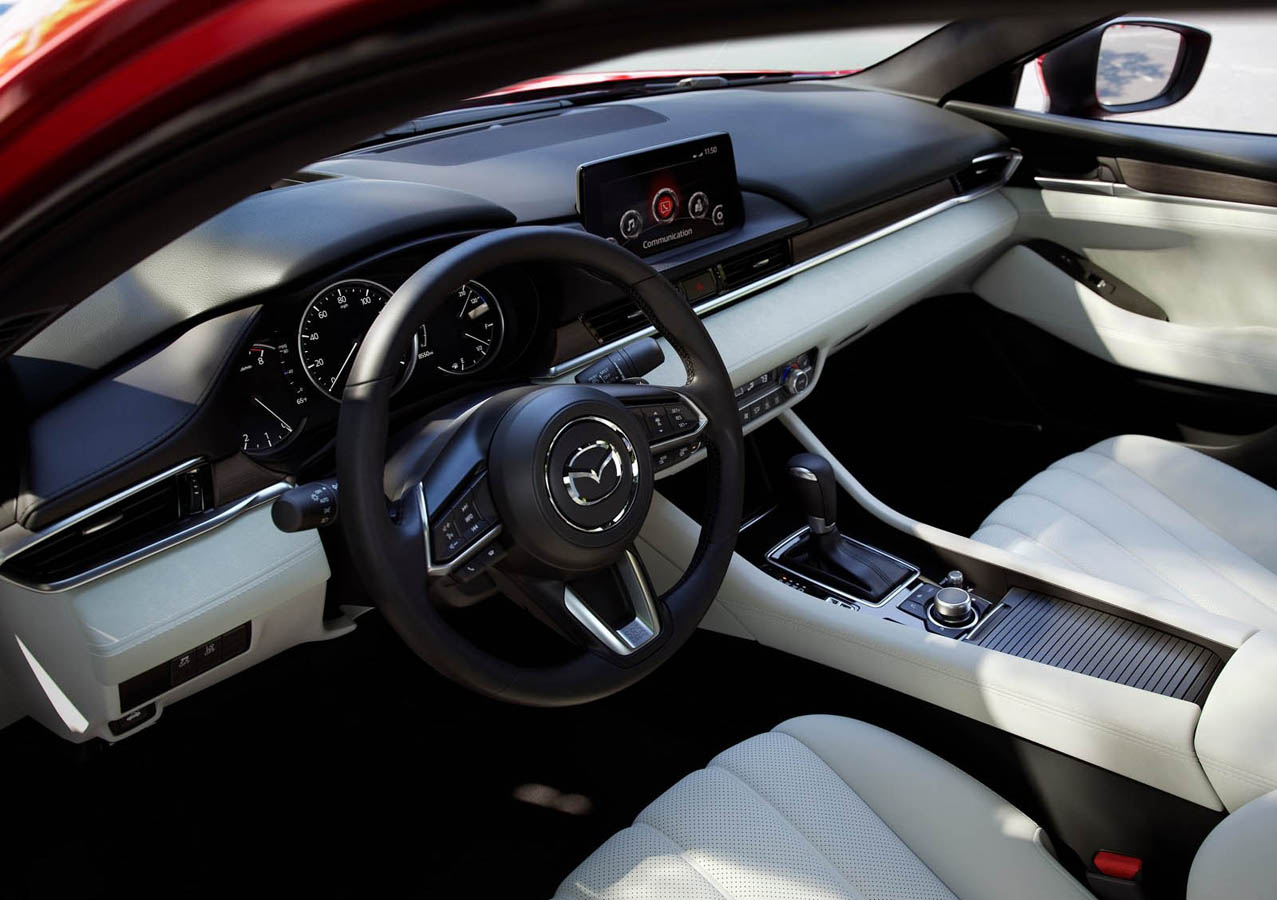
360° View Monitor
Using four cameras on the front, sides and rear of the vehicle, this system shows the area around the car on a central display. Eight parking sensors at the front and rear detect proximity to obstacles, and an alarm sounds.
When displaying the view in front of or behind the vehicle, the surroundings can also be seen at a glance with the separate overhead view. At 177 degrees, the front and rear wide-angle views display an extensive area.
Intelligent Speed Assistance (ISA)
ISA is a speed-limiting system that works in conjunction with Traffic Sign Recognition (TSR) to help keep drivers from exceeding the speed limit unintentionally or because they failed to notice a speed limit sign.
Mazda Radar Cruise Control (MRCC) with Stop & Go
Mazda Radar Cruise Control measures the relative speed and distance to the vehicle ahead and automatically controls the engine and brakes to maintain the appropriate vehicle speed and optimal following distance.
The updated MRCC uses both the millimeter-wave radar of the previous system as well as a forward-facing camera. This reduces its minimum operating speed from 30km/h down to 0 km/h. Available on all models with automatic transmission, the system now works at all speed ranges and can follow the car in front even from a standstill.
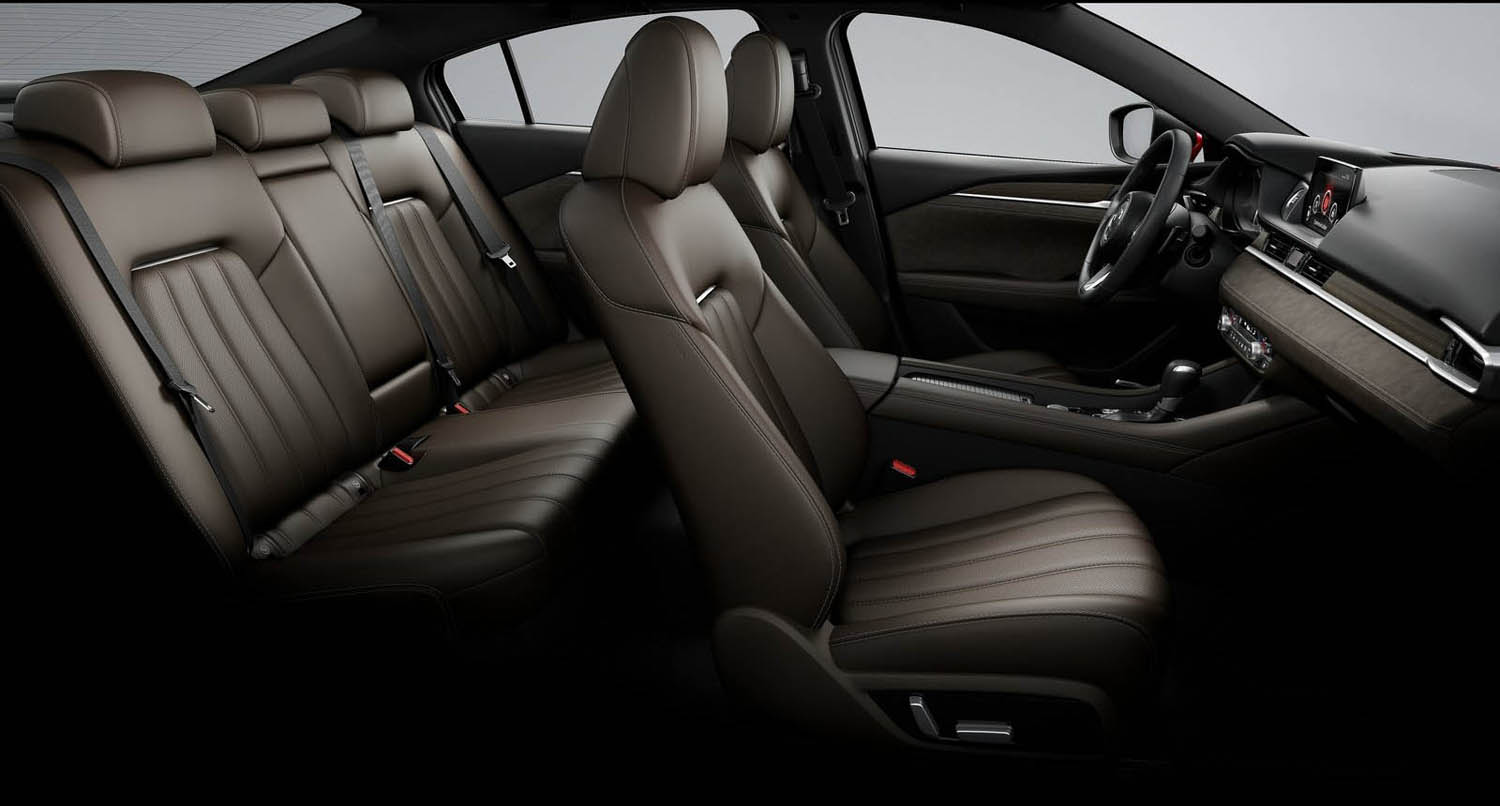
Advanced Smart City Brake Support (Advanced SCBS)
Advanced SCBS uses a forward-facing camera to detect vehicles and pedestrians ahead and help avoid collisions or mitigate damage in the event one does occur. The system can detect vehicles at speeds of 4 to 80 km/h and pedestrians at 10 to 80 km/h.
Additional i-ACTIVSENSE Active Safety Features
The wide range of additional i-ACTIVSENSE active safety features carried over from the previous model includes Smart City Brake Support – Reverse (SCBS R), Smart Brake Support (SBS), Advanced Blind Spot Monitoring (ABSM) with Rear Cross Traffic Alert, a Lane-keep Assist System (LAS) and Lane Departure Warning System (LDWS), Traffic Sign Recognition (TSR), Driver Attention Alert (DAA), Dynamic Stability Control (DSC) and Traction Control, 4-Wheel Anti-lock Braking System (4W-ABS) with Electronic Brake-force Distribution (EBD) and Brake Assist, an Emergency Signal System (ESS), and Hill Launch Assist (HLA).
Pedestrian Protection
The bonnet, cowl panel, front bumper and upper grille have been designed to soften the impact to the head and legs if the car strikes a pedestrian. In addition, the active bonnet immediately pops up at the rear when a collision with a pedestrian is detected, creating a space between itself and the engine.
Additional Passive Safety Features
In addition to enhanced pedestrian protection, the new Mazda 6 benefits from all the passive safety features of the previous model, which include a High-strength SKYACTIV body, Supplemental Restraint System (SRS) air bags, seat belts with pretensioners and load limiters, front seats which mitigate shock to the neck, rear seats that prevent luggage from entering the cabin, an impact-absorbing steering column, and ISOFIX child seat fastening points.
